Top Object Detection Algorithms
An overview of the top object detection algorithms.
Object detection is a computer vision task that aims to identify and locate objects in an image or video. This identification and localization make object detection suitable for things like counting objects in a scene, determining and tracking their precise locations, all while labeling them. In this post, we will go through the six most prevalent object detection techniques.
Histogram of Oriented Gradients (HOG) Feature Descriptor
Feature descriptors take an image and compute feature descriptors/vectors. These features act as a sort of numerical "fingerprint" that can be used to differentiate one feature from another. The Histogram of Oriented Gradients (HOG) algorithm counts the occurrences of gradient orientation in localized portions of an image. It divides the image into small connected regions called cells, and for the pixels within each cell, the HOG algorithm calculates the image gradient along the x-axis and y-axis.
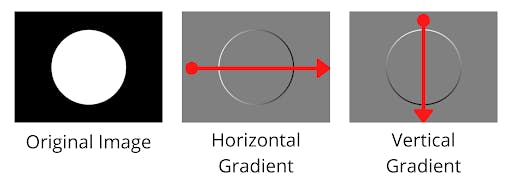 Pixel-wise gradients visualized
Pixel-wise gradients visualized
These gradient vectors are mapped from 0-255, pixels with negative changes are black, pixels with large positive changes are black, and pixels with no changes are grey. Using these two values, the final gradient is calculated by performing vector addition.
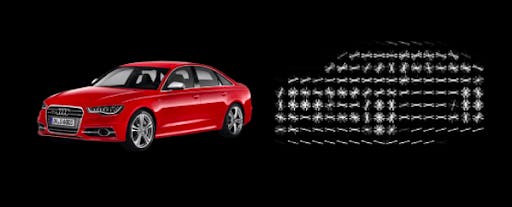 HOG features for a car
HOG features for a car
Let’s say we are using 8x8 pixel-sized cells, after obtaining the final gradient direction and magnitude for the 64 pixels, each cell is split into angular bins. Each bin corresponds to the gradient direction, with 9 bins of 20° for 0-180°. This enables the Histogram of Oriented Gradients (HOG) algorithm to reduce 64 vectors to just 9 values. HOG is generally used in conjunction with classification algorithms like Support Vector Machines(SVM) to perform object detection.
Region-based Convolutional Neural Networks (R-CNN)
 R-CNN architecture
R-CNN architecture
Convolution Neural Networks (CNNs) are not able to handle multiple instances of an object or multiple objects in an image. R-CNN first performs selective search to extract many different-sized region proposals from the input image to work around this limitation. Each of these region proposals is labeled with a class and a ground-truth bounding box. A pre-trained CNN is used to extract features for the region proposals through forward propagation. Next, these features are used to predict the class and bounding box of this region proposal using SVMs and linear regression.
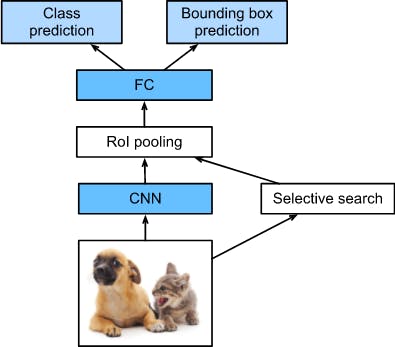 Fast R-CNN architecture
Fast R-CNN architecture
R-CNN selects thousands of region proposals and independently propagates each of these through a pre-trained CNN. This slows it down considerably and makes it harder to use for real-time applications. To overcome this bottleneck Fast R-CNN performs the CNN forward propagation once on the entire image.
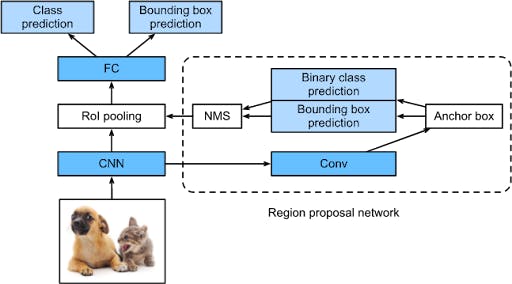 Faster R-CNN architecture
Faster R-CNN architecture
Both R-CNN and Fast R-CNN produces thousands of region proposal, most of which are redundant. Faster R-CNN reduces the total number of region proposals by using a region proposal network(RPN) instead of selective search to further improve the speed.
Region-based Fully Convolutional Network (R-FCN)
The R-CNN family of object detectors can be divided into two subnetworks by the Region-of-Interest (ROI) pooling layer:
- a shared, “fully convolutional” subnetwork independent of ROIs
- an ROI-wise subnetwork that does not share computation.
ROI pooling is followed by fully connected (FC) layers for classification and bounding box regression. The FC layers after ROI pooling do not share among different ROIs and take time. This makes R-CNN approaches slow, and the fully connected layers have a large number of parameters. In contrast to region-based object detection methods, Region-based Fully Convolutional Network (R-FCN) is fully convolutional with almost all computation shared on the entire image.
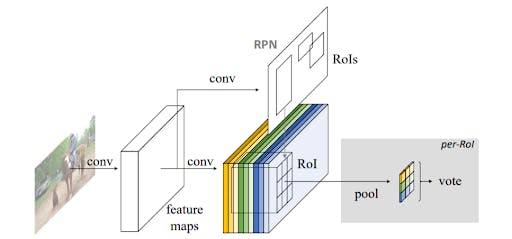 R-FCN architecture
R-FCN architecture
R-FCN still uses an RPN to obtain region proposals, but in contrast to the R-CNN family, the fully connected layers after ROI pooling are removed. Rather, all major computation is done before ROI pooling to generate the score maps. After the ROI pooling, all the region proposals use the same set of score maps to perform average voting. So, there is no learnable layer after the nearly cost-free ROI layer. This reduces the number of parameters significantly, and as a result, R-FCN is faster than Faster R-CNN with competitive mAP.
Single Shot Detector (SSD)
 Single Shot Detector (SSD) architecture
Single Shot Detector (SSD) architecture
Single Shot Detector (SSD) has two parts:
- a backbone model for extracting features
- an SSD convolutional head for detecting objects.
The backbone model is a pre-trained image classification network (like ResNet) from which the last fully connected classification layer has been removed. This leaves us with a deep neural network that can extract semantic meaning from the input image while preserving the spatial structure of the image. The SSD head is simply one or more convolutional layers added to this backbone model. The outputs are interpreted as the bounding boxes and classes of objects in the spatial location of the activations of the final layers.
Spatial Pyramid Pooling (SPP-net)
CNNs require a fixed-size input image, which limits both the aspect ratio and the scale of the input image. When used with arbitrary sized images CNNs fit the input image to the fixed size via cropping or warping. However, cropping might result in the loss of some parts of the object, while warping can lead to geometric distortion. Furthermore, a pre-defined scale does not work well with objects of varying scales.
CNNs consist of two parts: the convolutional layers, and fully connected layers. The convolutional layers work in a sliding window manner do not require a fixed image size and can generate feature maps of varying sizes. The fully connected layers, or any other classification algorithm like SVM for that matter, requires fixed-size input. Hence, the fixed-size constraint comes only from the fully connected layers.
 Network structure with a spatial pyramid pooling layer
Network structure with a spatial pyramid pooling layer
Such input vectors can be produced by the Bag-of-Words (BoW) approach that pools the features together. Spatial Pyramid Pooling (SPP) improves upon BoW, it maintains spatial information by pooling in local spatial bins. These bins have sizes proportional to the image size, this means the number of bins remains unchanged regardless of the image size. To use any deep neural network with images of arbitrary sizes, we simply replace the last pooling layer with a spatial pyramid pooling layer. This not only allows arbitrary aspect ratios but also allows arbitrary scales.
SPP-net computes the feature maps from the entire image once and then pools the features in arbitrary regions to generate fixed-length representations for the detector. This avoids repeatedly computing the convolutional features. SPP-net is faster than the R-CNN methods while achieving better accuracy.
YOLO (You Only Look Once)
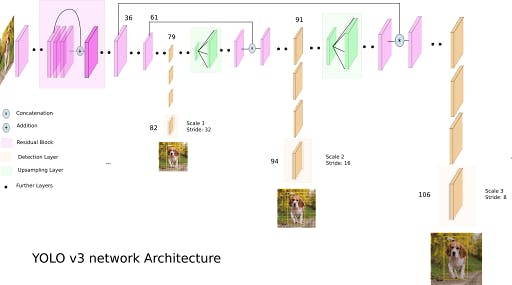 YOLOv3 architecture
YOLOv3 architecture
You Only Look Once (YOLO) detectors take the image and draw a grid of small squares. From these small squares, they regress off of the square to predict the offset they should put the bounding box at. On top of these grid cells, YOLO models have anchor boxes with varying proportions that enable the model to detect objects of different sizes in different orientations. For example, if you have cars and traffic lights in a dataset, you would need skinny and tall anchor boxes for traffic lights and wide and flat ones for cars. YOLO uses a single deep neural network to predict the bounding box and the class of the objects.
This list is by no means exhaustive, there are a plethora of object detection techniques beyond the ones mentioned here. These are just the ones that have seen widespread recognition and adoption so far.
If you enjoyed this introduction to state-of-the-art object detection techniques and want to learn how to build real-world applications using YOLOR, you can enroll in AugmentedStartup's YOLOR course here.
This post is a part of my crossposts series which means I wrote this for someone ekse, the original article has been referred to in the canonical URL and you can read it here.
